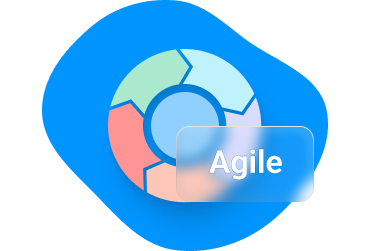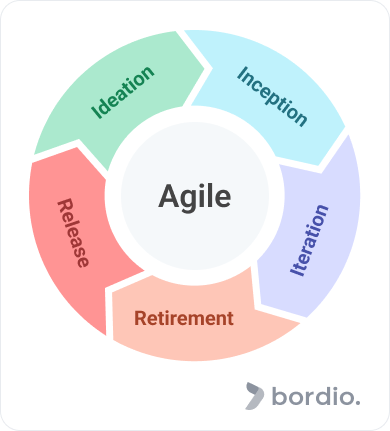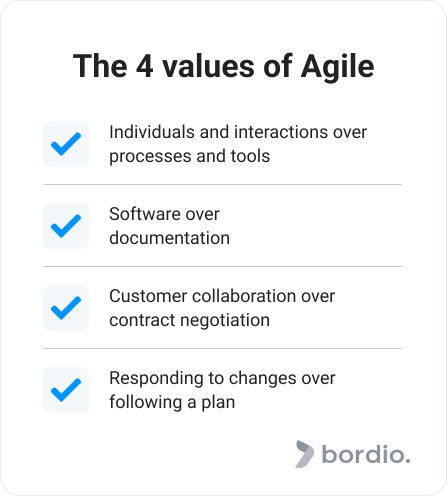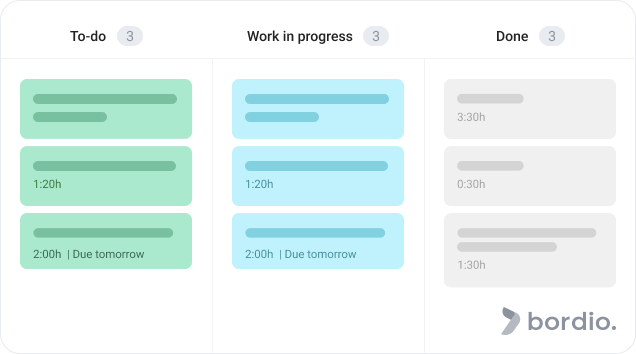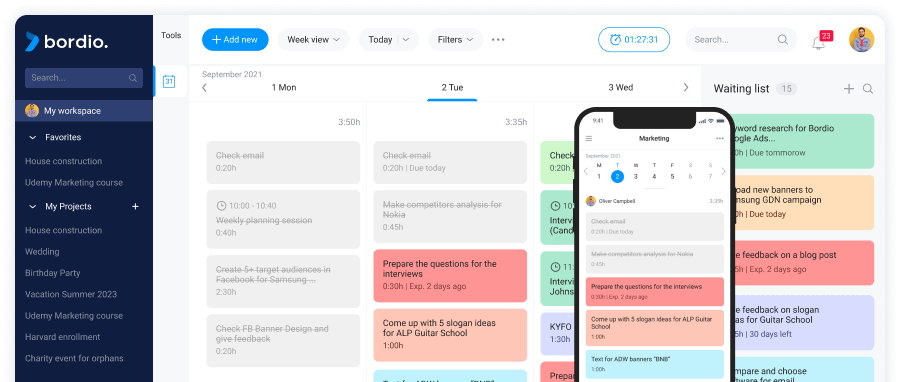Agile is an iterative methodology of delivering a project. It is often perceived as a philosophy and a way of thinking over a framework or process.
As a term, Agile was coined in 2001 and quickly became a revolution in the world of project management and product development.
Unlike the bulky and inconvenient traditional project management, like PRINCE2 and Waterfall, with its strict rules and lengthy change control processes, Agile workflow offered iterative and progressive methods and became a breath of fresh air.
A few facts about the Agile approach before we dive deep into details:
- Agile strives to deliver value in increments during shorter periods of time. It helps businesses test and start using the solution faster, as well as share the feedback sooner
- The method was primarily used in software development, but nowadays Agile process starts to branch out into other industries.
- There is usually no project manager in Agile and teams are largely cross-functional, meaning that their roles might change and shift as the project goes on.
- A set of stages leads the Agile development workflow from the idea to the final result. In each stage, the progress is reviewed, stakeholders share their feedback, and developers fix issues before moving on to the next stage.
- Huge benefits of Agile are improved productivity and having everyone on the same page.
- Many appreciate Agile workflow for its flexibility and adaptivity to changes. As you may guess, a lot of software-related projects change and derail from the original vision, so it helps a lot to not be stuck in a concrete project plan with little to no wiggle room.
Stages of Agile Workflow
Let’s look into the main stages of Agile workflow.
Now, Agile pioneers adaptivity, so people like to make it their own and change a few bits here and there. Changes are possible and welcome, so you will see a slightly different format of the Agile workflow. However, the one we will be showcasing today is a pretty standard by-the-book version of it.
Ideation
Ideation, also known as Conception, is the first stage of the project. Here, the initial project plan is drafted, and the business scope is negotiated.
That’s where a lot of meetings with project stakeholders are held to understand the business need and user pain, as well as acceptance criteria. It is often during the Ideation stage when finances, timelines, and resources needed are discussed.
Tip: Use an online to-do list app to write down all key points from the ideation stage. Things tend to be forgotten if they’re not written down so time planner app would be extremely useful. And it will be less confusing to everyone if they can refer to a list to double-check themselves. And using such a schedule planner online for teams will help not to repeat the same thing many times, because everyone will have access to view, for example, goals and tasks.
Inception
Once the main idea is clear, we understand why the project is required, and what issues it should solve, the development team comes together to go through all project details and discusses the scope of work, the milestones, risks, target audience, timeframes, and expected deliverables. This stage is often called Inception or Initiation. This is also conveniently done in schedule maker online free for convenience.
The team breaks the project down into smaller time increments to make it easier to manage: work is divided into smaller time frames which typically take 2-4 weeks to complete.
Disclaimer: such time increments would often be called Sprints which is a part of the Scrum framework that follows Agile principles which is called Agile Scrum. It is important to note that Scrum is always Agile, but Agile is not always Scrum. In this article, we will be calling time increments Sprints for simplicity.
Depending on the Agile framework that the team follows, people might get assigned specific tasks and responsibilities aligned with their expertise, or the tasks can be picked up freely based on one’s desire and availability. So by reviewing the tasks in task organizer app they will be able to make informed decisions and get to work.
Iteration
The third stage is Iteration, and at this point of the Agile project management process, the team would usually do the following:
- Identify the requirements for the Sprint to help narrow focus and achieve the best results and reach the most important goals.
- Product design, including drafting a mockup, considering UX, and researching competition.
- Software testing. Once the coding is over, it’s time to run the tests and make sure everything works as it is supposed to.
- If applicable, the team would also check how the solution integrates with the rest of the environment or infrastructure.
Depending on the project size or complexity, the team would run as many sprints as required to finish all tasks and create a product that fits the project requirements and business needs. So using work management systems to accomplish all tasks will be the right thing to do.
Release
Release of the solution can mean a fully functioning product or a beta. The solution would be released at the end of each Sprint, allowing business users to check and test it immediately, share their feedback, and start using it right away.
Once the solution is fully out, and the customer feedback starts to come in, the team will start working on improvements and bug fixes using the same Sprint model.
It is possible that by the end of the Sprint, the requirements or priorities for the project change. In that case, Sprint teams review their task list accordingly and adapt to the business needs for their next Sprint session. You can control your team while scheduling Sprint sessions by using team management tools.
Retirement
The project stage when the Agile workflow process ends is called Retirement.
There are 3 main scenarios when that happens:
- The product becomes obsolete and cannot be updated to fit into the market anymore, so it is time to retire it.
- The solution can be retired because the company went bankrupt.
- The business has made a dramatic shift in focus, leaving the solution irrelevant in the new strategy.
The 4 values and 12 principles of the Agile Manifesto
The Agile methodology has a well-known set of values and principles that are an integral part of the Agile development flow and help better understand the system.
They originated in the US, where a group of software developers has come together to share ideas and approaches to their work which they then summarized in the manifesto.
The values act as a project management tool and guide the development process and delivery, helping Agile teams stay on track.
People should be valued more than tools and processes because it is people who drive the development process. When humans are prioritized, there is a better response to change, and customer needs are better met. Agile insists on viewing change not as an unwanted expense but as an opportunity for improvement and a chance to deliver more value.
Similarly, collaboration with a client should be more important than contract negotiation. In fact, Agile methodology recommends engaging (at least occasionally) the client in sprint reviews, demos, or other project stages. That helps the client feel like a part of the team, making them more eager to collaborate and listen. At the same time, the team gets to hear ad-hoc feedback, which they then integrate instantly. As a result, there is a better understanding between the two parties, and the project is more likely to succeed and deliver true value to the business.
Lastly, development is more important than documentation. Active work on the solution should not be compromised because specifications and other technical documents have to be prepared first. Formalities can take days, if not weeks. We cannot afford to lose so much time.
Tip: A good daily planner will help the team stay on track with both core goals (development) and supportive tasks (documentation). A project organized with the help of daily schedule planners is more successful.
The 12 principles of Agile
The 12 Agile principles support the 4 values and further explain what it means to follow the Agile workflow process:
-
Customer satisfaction is the highest priority, and it is achieved through the early and continuous delivery of valuable software.
-
Change requests are welcome at any stage of the development and will be used as the customer’s competitive advantage.
-
Working software is delivered frequently within a few weeks or a few months. Deliver working software frequently, from a couple of weeks to a couple of months.
-
Business people and developers work together daily.
-
Projects should be built around motivated individuals in an environment of trust and support.
-
A face-to-face conversation is the most efficient and effective method of sharing information.
-
Working software is the primary measure of project progress.
-
It’s all about sustainable development so that a constant pace can be maintained.
-
Attention to technical excellence and design enhances agility.
-
Simplicity is essential. Less is more.
-
Self-organizing teams produce the best architectures, requirements, and designs. The virtual planner app can help with this.
-
The team uses regular intervals to reflect, become more effective, adjust its behavior and As well as review their successes and progress in digital daily planners.
The principles are ingrained into the Agile development workflow, so it is important that Agile teams (or Spring teams) are sincerely eager to adapt their project management and system development processes in accordance with the Agile principles.
Choosing an Agile Workflow Framework
Agile is a concept. The framework is a template for bringing this concept to life.
The Agile methodology supports many frameworks that you can choose from depending on personal preferences or the convenience of your individual project.
There is a great number of popular agile workflow models out there, for example, extreme programming. Today, however, we will focus on the most common ones, which are Scrum, Kanban, and Lean.
Scrum
Scrum is, perhaps, the most popular framework for Agile project management. It promotes self-discipline, personal responsibility, continuous improvement (whether of one’s skills or the product).
Here are the main principles of Scrum:
- The Scrum’s big vision is to develop the best product possible in a short amount of time, using the resources available.
- All tasks are divided into Sprints that take 2-4 weeks in general.
- Effective team collaboration is essential for working on issues and problems.
- Team members learn along the way and adjust to the situation.
- Product backlog plays a critical role in the project.
- Product owners are encouraged to review the unfinished tasks one by one, grab customer feedback from stakeholders, prioritize the tasks accordingly and start working through them.
Product backlog in the Scrum world is a list of every single feature and functionality that an end product needs to have.
The Waiting list in Bordio’s free calendar planner is the perfect tool for drafting such a product backlog. Spaced conveniently to the right from your main project view, all unscheduled tasks can be reviewed instantly, letting you plan your week or your Sprint with the backlog in mind.
Kanban
Kanban became one of the most popular Agile workflow management frameworks largely thanks to its iconic process visualization via Kanban board.
The Kanban board is sometimes also called the Agile board or Scrum board. It consists of columns and cards that help see the scope of work and add a bit of gamification to the process. The columns can be as simple as “to do”, “work-in-progress”, “done”, or Agile teams can customize them for their personal needs and preferences.
The cards are moved from one column to the other, allowing continuous workflow. The team members are free to pick whatever task they want and start implementing it. There is no strict assignment to who does what.
The only recommendation that Kanban has is to limit the number of tasks that can be in the work-in-progress column simultaneously. That way, the tasks are not only started but also finished quickly.
Here are the main principles of Kanban:
- All steps of the process are 100% transparent.
- Kanban board is used to visually represent the project tasks and steps.
- The framework allows the continuous workflow to produce the maximum outcomes.
- Changes can happen at any point in the project.
Lean
With the Lean development process, the team is the core decision-maker in the process.
This framework eliminates all kinds of waste in every way possible to help Agile teams get the best high-quality results. It emphasizes the idea that waste is expensive, whether it’s the busy work, extra supplies, or having to deal with issues that could have been prevented.
Main principles of Lean management process:
- Testing plays a special role and is carried out via multiple iteration cycles.
- The framework helps get the product out in the shortest amount of time.
- The continuous improvement concept is applied not only to solutions but to the processes too.
Whatever framework you pick up for your project, remember that all of them are a part of the Agile method, so it is okay if your way of implementing them differs from the traditional approach. Agile workflow celebrates change and adaptivity, so you can mix and match Lean, Scrum, and Kanban together.
In fact, so many people are doing it that there is a term for a mix of Scrum and Kanban – Scrumban!
The role of Agile Roadmap in Agile workflow
If you decide to implement Agile workflow in your project, we highly encourage you to create an Agile roadmap.
The roadmap helps plan the long-term direction of the product. Your developers will have a better idea of what the future holds, and they will be able to work on the shorter-term tasks keeping in mind the next scheduled features and enhancements. It works as motivation because there is always something to look forward to. But also, it allows the project team to be more strategic and think about how their current work will affect future iterations and vice versa.
The benefits of using Agile Workflow
Agile workflow has grown a huge fanbase over the years and continues to be one of the top methodologies used in product development and beyond. Naturally, it wouldn’t become as popular if it weren’t for many benefits that it gives:
-
Creates a structure to the project allowing to avoid unnecessary actions and chaos in the software development cycle.
-
Helps plan ahead and prevent the issues associated with reworking the product and fixing bugs.
-
Should bugs or issues still come up, it is easier to track their origin and know where to start on fixing them.
-
It is adaptive and fits the ever-changing technological world better.
-
The Agile approach is customer-centric, which results in more satisfied clients and highly successful products.
With the Agile workflow process implemented, companies manage to reduce costs, manage risks and uncertainties better, face the unknown without fear, and make better decisions.
Final thoughts on Agile workflow
Agile workflow helps organizations of all sizes release high-quality products within the timeframe and budget. It is a soft and adaptive approach to project management that promotes feature-driven development and increases the chances of successful project delivery.
Before implementing Agile workflow, get your team and all stakeholders familiarized with the concept and its principles, and introduce supportive tools, such as digital weekly planners. That way, no one will be wondering why you’re doing what you’re doing, and everyone will contribute to the project.
And remember, being Agile means being flexible and adaptive. So, as you start integrating it, be kind to yourself and your team. Don’t worry about not acing something right away, and keep on improving over time.
